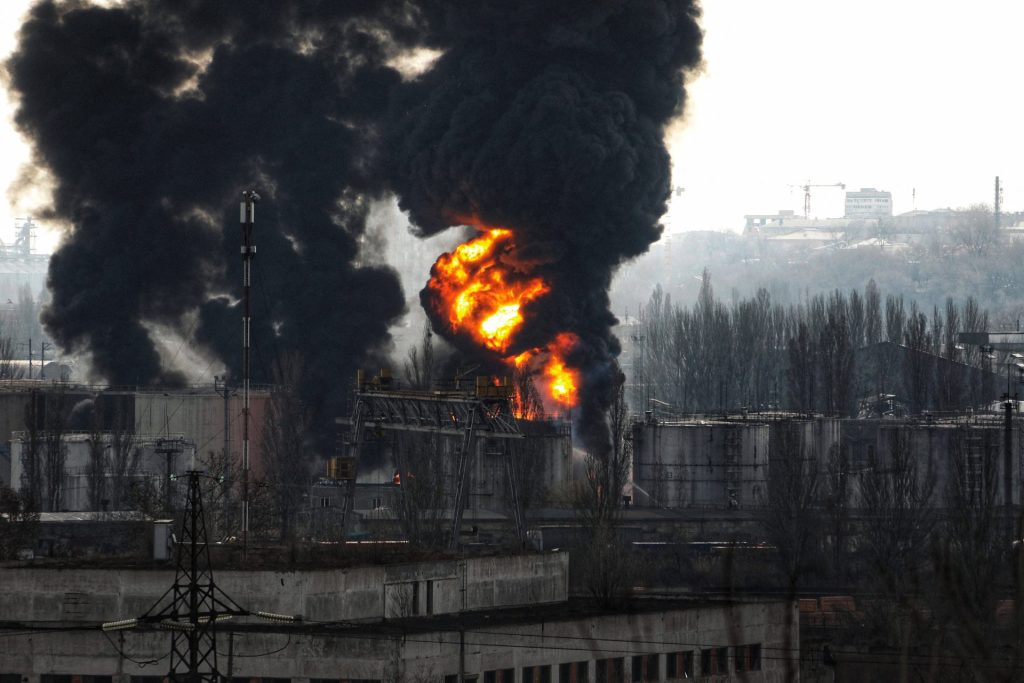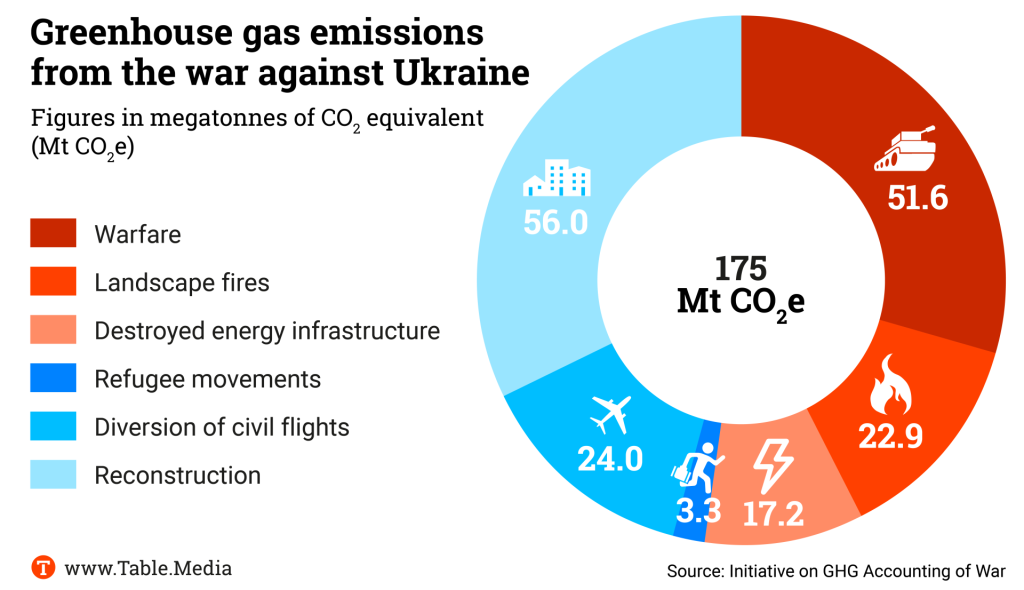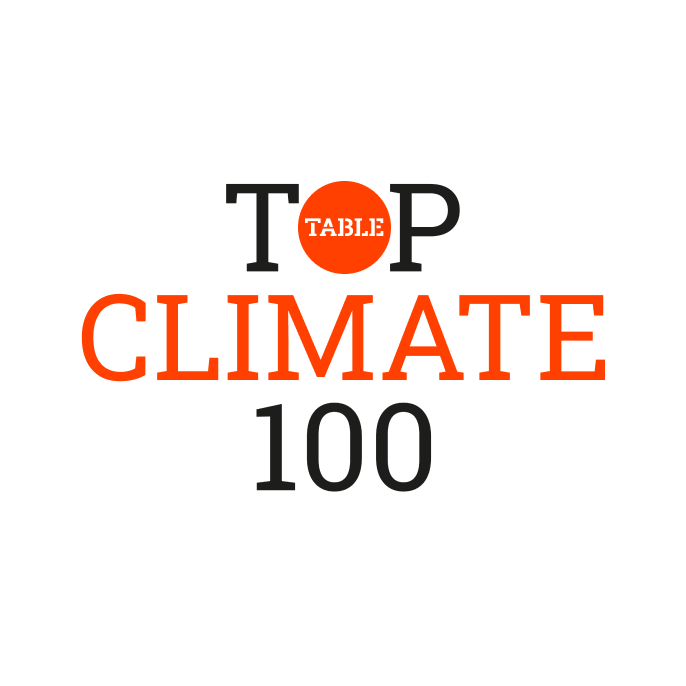Climate finance is one of the biggest issues of the year. Alexandra Endres asked the EIB’s senior climate expert, Nancy Saich, where the money from the European Investment Bank (EIB) is going. Generally speaking, “far too much money continues to flow into the wrong things,” for example, in fossil fuel subsidies, Saich criticizes. Her bank has already adopted stricter lending rules. However, Saich calls for faster decisions on the global climate finance target.
The Russian attack on Ukraine has caused unimaginable human suffering and also resulted in severe ecological damage. A study has now summarized the climate and environmental damage in Ukraine. Anouk Schlung has analyzed why, alongside the war, rebuilding will also be decisive for the emissions budget.
We also take another look at the German national budget. A study by the MCC suggests that the CTF special climate fund stands on feet of clay. Economy and climate action minister Robert Habeck will have to find solutions to this – the MCC offers suggestions to boot – as well as to climate policy with China. Habeck will arrive in Beijing on Friday. In today’s opinion piece, the environment and development organization Germanwatch has six proposals for “non-naive cooperation” with China.


Ms. Saich, climate policy sees a battle for a new climate finance target. Developing and emerging countries want hundreds of billions of euros in annual aid. What do you think the new financial target should look like?
The EIB has observer status in these negotiations. It is not our place to formulate our own demands. Personally, I hope that there will be new payments into the loss and damage fund in the course of the year. And regarding the new financial target, it is important that we don’t just need a number, we also need quality. The target must be ambitious, and yet everyone must be able to agree on it. My impression is that the troika from the United Arab Emirates, Azerbaijan and Brazil is very active. There are positive signals, but we are not nearly as fast as we should be. Far too much money continues to flow into the wrong things, such as subsidizing fossil fuels. That has to stop.
The EIB also lends climate loans to countries outside the EU. Where does the money go? To wealthy emerging countries with strong business opportunities, or to particularly disadvantaged countries that might need it more urgently?
We are a bank and we grant loans. However, with it, we can hardly solve the problems of already over-indebted countries. Even particularly low-interest loans or instruments such as the currently hotly debated “debt-for-nature swaps” would not help these countries. I think the solution for them is more likely to be found in the proposals of the Bridgetown Agenda.
The EIB is financing the EU’s Green Deal. After the shift to the right in the elections, how secure is the EIB’s continued climate leadership role?
The new EIB President Nadia Calviño, who has been in office since January, has made it clear: Continuing our work as a climate bank is one of her top priorities. We are working on our climate roadmap for 2026 to 2030, and our communication needs to be much stronger: A greener future benefits everyone, not just the climate. It will bring new jobs, better homes, cleaner air and better health. Our goal is a just climate transition that leaves no one behind. And these are not just empty words.
You say that too much money continues to flow into the wrong things. The EIB is one of the world’s largest financiers of climate action and sustainability. What criteria do private companies or the public sector must meet in order to receive a climate loan from you?
As the EU’s climate bank, we finance the Green Deal. We have set out 2020 in our climate roadmap: By the end of 2020, all EIB financial activities must be in line with the Paris Agreement. 50 percent of our loans are to flow into climate and green projects from 2025. And from 2021 to 2030, we want to support the fair, green transformation of the economy with investments of one trillion euros. Of course, we have not yet implemented everything, but we are making good progress. More than half of EIB lending now goes towards climate finance.
Which activities does the EIB fund and which does it rule out?
Since 2021, we have only been funding new activities that, according to the EIB-Paris Alignment Framework, help our clients meet the goals of the Paris Agreement. We focus our climate loans on the energy sector, namely renewable energies, energy efficiency, grids and electricity storage. We also grant loans for the expansion of local public transport and building refurbishment, for example. Since 2020, we generally no longer grant loans for conventional energy generation from fossil sources – however, we do not withdraw existing loans, as we are contractually bound to agreed projects as a public financial institution. We systematically examine all projects that are submitted to us for possible climate risks. We help our clients understand the impact of climate change on their business and how to reduce their emissions. And we support banks in green lending, for example to small and medium-sized enterprises or smaller municipalities.
Would the EIB fund new natural gas projects or fossil fuel power generation with CCS?
Our standards exclude any form of electricity generation that produces more greenhouse gases than 250 grams of CO2 equivalent per kilowatt-hour. This makes us stricter than the EU taxonomy, which sets the limit at 270 grams. The 250-gram limit means that even the most efficient form of conventional fossil power generation is excluded – so we do not finance combined-cycle gas turbines, for example. However, highly efficient combined heat and power plants that supply residential areas with electricity and heat can meet our criteria. We do not finance the extraction of coal, oil or gas, nor do we finance pipelines or other fossil fuel infrastructure.
In 2023, the EIB Group funded climate projects with 49 billion euros, the equivalent of 60 percent of the total lending volume. Why not more?
Because our mandate also requires us to finance other objectives. We support small and medium-sized enterprises and promote innovation in the education and healthcare sectors, such as the development of vaccines. There is currently also a growing interest in defense and digitalization loans. Not everything we do promotes the green transformation of Europe – after all, we can’t stop funding schools or hospitals. But everything must be done in line with the Paris Agreement. This means, for instance, that any hospital we fund is aware of its climate risks and is adapting accordingly. The other multilateral development banks, with whom we have been working closely on climate finance issues since Paris, use a similar approach.

Between February 24, 2022, and February 24, 2024, Russia’s war of aggression against Ukraine generated 175 million tons of CO2. These emissions are equivalent to the annual use of 90 million cars. This figure is one of the most important findings of the study “Climate Damage Caused by Russia’s War.” Its main author, climate researcher Lennard de Klerk from the Warbon Initiative on GHG Accounting of War, presented it in mid-June on the fringes of the Ukraine Recovery Conference (UCR) in Berlin.

The biannual paper compiled by a multinational research team summarizes the climate damage in the first two years since the start of the Russian invasion of Ukraine in February 2022. The emissions are broken down into different areas:
What the authors of the study have not calculated: The emissions avoided by the destroyed infrastructure. Before the war (2021), Ukraine’s carbon emissions still amounted to 210 million tons, according to the Global Carbon Atlas. In 2022, it was 141 million tons. In October 2023, the country was short of 44 percent of its nuclear power capacity, 78 percent of its thermal power capacity (mostly coal and gas) and 60 percent of its combined heat and power capacity due to war damage or Russian occupation.
Once the energy system is rebuilt, it will be important to replace the old infrastructure with greener ones. Last week, Greenpeace published a kind of “solar Marshall Plan” that sets out what this reconstruction could look like.
The study’s authors estimate that rebuilding the roads, residential buildings, and other infrastructure destroyed by the war will account for the majority of emissions, at 56 million tons.
Other environmental damage caused by the war is also enormous. Ruslan Strilet, the Ukrainian Minister of Environmental Protection and Natural Resources, told Table.Briefings that his ministry registered over 4,900 cases of environmental damage since 2022. The most severe damage includes air pollution from toxic gases caused by explosions and fires, water pollution, the destruction of Ukrainian forests and massive damage to Ukrainian flora, fauna and nature reserves.
According to Strilet, however, the attack on the Kachowka hydropower plant in June 2023 had the worst environmental impact. It flooded 63,400 hectares of forest-more than two-thirds of Berlin’s area.
June 21-22, Berlin
Conference Progressive Governance Summit 2024
Under the motto “Progressive Security: Championing Change in Times of Uncertainty,” the conference will focus on dealing with the climate crisis, among other things. Info
June 25, 4 p.m. CEST, Online
Webinar Next Generation NDCs: Setting Sectoral Targets to Maximize Impact
Countries are due to unveil new national climate commitments (NDCs) under the Paris Agreement by early 2025. This webinar, organized by the World Resources Institute (WIR), will discuss how sector targets can be meaningfully integrated. Info
June 26-28, Bonn
Conference International Energy Workshop
The IEW is a leading conference for the international energy modeling community, organized by the International Renewable Energy Agency (IRENA). Info
June 26-28, Valencia
Conference European Urban Resilience Forum
The conference, organized by ICLEI Local Governments for Sustainability and the European Environment Agency, will focus on topics such as water, the blue economy, and climate-neutral cities. Info
June 26, 3 p.m. CEST, Online
Webinar The Use of CBAM Revenues
The CBAM’s transitional period is now underway, but there are still some unanswered questions. The ERCST’s second report of CBAM V will look at the topic of CBAM revenue use, as this is of increasing importance to international stakeholders. Info
June 27, 9:30 a.m. CEST, Berlin
Status conference Thermal storage for the heat transition
The role of thermal storage systems in the heating transition will be discussed at the conference. It is organized by the Energy Storage Systems Association (BVES). Info
The steady growth of EVs in recent years is having an impact: From 2027, global fuel demand for road transportation could decline, according to new data from BloombergNEF (BNEF). The think tank predicts that 83 million electric cars, buses and trucks will displace combustion vehicles worldwide by 2025. In addition, there will be 340 million electric scooters, motorcycles, and tricycles. Without these EVs, the demand for fuel in road traffic would continue to increase until 2041, according to the calculations.
BNEF analysts say electric vehicles are no longer just in demand in rich countries. Countries such as Thailand, India, Brazil and Turkey are currently experiencing a huge boom. China, France and the UK also saw high growth rates of 20 to almost 40 percent in the first quarter of 2024 compared to the same period last year. The market recently weakened in Italy (minus 24 percent), Japan (minus nine percent) and Germany (minus three percent). nib
After India connected fewer and fewer new coal-fired power plants to the grid in recent years, the country plans to build significantly more coal-fired power again. A total of 15.4 gigawatts are to be added by March 2025. This would be the highest increase in the last nine years and twice as much as in 2024, Bloomberg reported on Monday, citing anonymous sources. According to official information, power plants for 90 gigawatts of coal-fired power are to be built by 2032.
Over the last ten years, India has added 100 gigawatts of renewable energy, more than thermal energy. However, three-quarters of electricity is still generated using coal. Insufficient energy storage and rising energy consumption due to the growing economy prolong dependence on fossil fuels. According to the Carbon Action Tracker, the country pursues a “highly insufficient” climate policy – yet is itself severely affected by the consequences: Electricity consumption increases significantly, especially during heatwaves, as refrigerators and air conditioners are running hot. lb
As part of the current budget negotiations for 2025, the Mercator Research Institute on Global Commons and Climate Change (MCC) is calling for grants from the federal budget for the Climate and Transformation Fund (CTF). Otherwise, it would be difficult to finance important funding and investment programs. Following the cuts resulting from the ruling of the Federal Constitutional Court in November 2023, the study examined the financial structure of the CTF and found that the funding for many climate action instruments in 2025 is uncertain. It concludes that the CTF special fund is overstretched.
According to the authors, this is due to several reasons: Following the loss of the 60 billion euro reserve, the CTF is now essentially funded by European and national carbon pricing. However, the authors say that carbon price revenues fluctuate due to the economy and are not certain. At the same time, the authors assume that the costs of the EEG levy, which is financed by the CTF, will rise. Ultimately, this means an uncertain source of income coupled with rising expenses in the CTF. “Funding and state investments, on the other hand, must be secured so that there is planning security and no abrupt discontinuation of programs,” says Ann-Kathrin Schenk, Head of the Policy Unit at the MCC. Sudden funding stops would damage the credibility of climate action measures, she says.
That is why the study’s authors call for fixed funds from the federal budget for the CTF to ensure reliable financing or a restructuring of the special fund: The climate action measures could be incorporated into the core budget with reliable financing and the fluctuating income from the carbon price in the CTF could be used primarily to compensate citizens and companies. seh
The European low-cost airlines Ryanair, Easyjet and Wizz Air call for non-CO2 emissions from all flights – including international long-haul flights – to be recorded and disclosed. From 2025, airlines in Europe will have to collect and disclose emissions from soot, nitrogen oxides and water vapor in addition to direct carbon emissions in emissions trading for the first time. However, the European Commission plans to exempt long-haul flights from the monitoring regulations for non-CO2 emissions.
According to the European Union Aviation Safety Agency, airlines’ non-CO2 emissions have at least as much of an impact on global warming as their carbon emissions. A draft Commission proposal for the new rules seen by Reuters suggests exempting international flights from the rules for two years. “Such reporting shall only be required in respect of routes involving two aerodromes located in the European Economic Area,” the proposal states. Flights from the EEA to Switzerland or the UK are also to be included.
“The blanket exclusion of extra-EEA routes would give the misleading impression that these routes create no non-CO2 warming effects, misdirecting all future non-CO2 mitigation measures,” the airlines said in a joint statement distributed to EU governments. rtr/luk
An alliance of representatives from science, business and environmental organizations has criticized the poor quality of data on the expansion of Germany’s power grids. They state in a letter to the Federal Network Agency, which was published on Wednesday, that the data provided on the portal VNBdigital cannot be automatically accessed and is also of poor quality in some cases. The data is “indispensable, for example, to optimize energy systems and accelerate the expansion of renewable energies,” write the signatories, which include representatives from various universities and research institutes as well as Environmental Action Germany and the German Renewable Energy Federation.
The data on the distribution grids is needed, among other things, “for the geographical analysis and planning of renewable energies and new consumers such as charging stations and heat pumps,” the letter states. The signatories are calling on the Federal Network Agency to provide distribution grid operators with specific requirements: The data should be made available in machine-readable format and standardized quality in a central database. Furthermore, an open license should create clarity for data usage.
When asked by Table.Briefings, the Federal Network Agency expressed surprise at the open letter. “So far, the signatories have not sought dialogue with the Federal Network Agency,” said a spokesperson. “In this respect, it has not yet been possible to hold a dialogue.” By publishing the grid expansion requirements, transparency is “already significantly higher than in the past.”
Nevertheless, the Agency is “open to suggestions as to how the usability of the information and data can be improved for third parties.” However, the spokesperson said that it is still unclear “to what extent a determination procedure by the Federal Network Agency is necessary and possible for all sub-areas and whether adjustments can also be sensibly implemented outside a formal procedure.” mkr
On Monday, a US district court dismissed a lawsuit filed by oil giant ExxonMobil against the activist group Arjuna Capital. In addition to Arjuna Capital, Exxon had also sued Follow This. Exxon’s accusation: The organizations had “abused” the voting procedure at the shareholders’ meeting and “infiltrated” it as activists. They had tried to persuade Exxon to take more climate action – without success. The lawsuit was dropped because Arjuna Capital agreed not to submit any further voting proposals at the shareholder meetings and not to submit any proposals regarding Exxon’s greenhouse gas emissions. However, Exxon has the option to file another lawsuit.
Arjuna Capital has not yet commented on the court decision. Although Follow This does not believe that shareholders’ rights are at risk, it assumes that Exxon will continue its “aggressive agenda” instead of returning to a constructive dialog. rtr/lb
While Germany debates whether the German Supply Chain Act (LkSG) should be suspended, the law and the European Supply Chain Directive (CSDDD), which will not come into force for another two years, are already having a noticeable impact. The European solar industry, which is heavily dependent on China, is already switching to compliant purchasing strategies. In addition to the general human rights and environmental standards, they must also take into account the oppression of the Uyghurs and the allegations of extensive forced labor programs in the Xinjiang region.
For example, the solar system seller Enpal from Berlin imports its products from the three provinces of Anhui, Zhejiang and Jiangsu. “We can be 100 percent certain that no forced labor is involved,” says Henning Rath, Chief Supply Chain Manager at Enpal in Shenzhen. According to Rath, solar products from Xinjiang are increasingly only being produced in China for the domestic market.
China dominates the sector’s global supply chains – down to complete solar energy systems. Manufacturers buy preliminary products in China, installers usually buy entire systems. EU solar companies have to set up new supply chains for these purchases entirely outside Xinjiang – and all of this has to be certified. After all, independent human rights audits are not possible in Xinjiang.
For some time now, the United States has banned imports from Xinjiang unless forced labor can be explicitly ruled out. Although the alleged forced labor in the regions inhabited by Uyghurs will most likely not end, human rights-compliant supply chains specifically designed for trade with Western countries are being established. ck/lf
Read the full analysis in China.Table

Robert Habeck will arrive in China on Friday for his first visit as Minister for Climate Action. His presence is especially significant because China is undoubtedly the key player for successful global climate action in multiple ways:
It is, therefore, high time for the German government to prioritize climate policy relations with China. Important foundations have been laid since the beginning of this legislative term with the climate foreign policy strategy, the China strategy and the transformation dialogue agreed upon a year ago between Germany and China.
Now it is crucial to implement a realistic and strategic China climate policy. The guiding principle should be “pragmatic cooperation.” This means cooperation in areas where it is still sensible and possible, but also clearly defined expectations and a different approach to third countries.
Robert Habeck can set priorities in Beijing in the coming days in six areas: First, he should acknowledge that we will continue to need large-scale imports from China for the necessary transformation but also explain why Europe wants to diversify its supply chains in future technologies like renewable energy and electromobility. This includes building its own production capacities, but not closing the market.
Second, he should demand that the ecological and social conditions in the supply chain – for example, for solar cells – improve. The use of forced labor or exclusive reliance on dirty coal power is unacceptable. German and European supply chain laws are the best tools to achieve actual improvements because they are binding for all large companies. Habeck’s public consideration of “suspending” the German law did not strengthen this position’s credibility. It is, therefore, important that he clarifies that binding due diligence obligations are coming and how China can create the necessary transparency for this.
Third, the high share of coal-fired power generation remains China’s biggest climate policy problem. The minister should set clear expectations: China must finally adhere to its 2021 commitment to strictly limit the increase in coal power plants and initiate a coal phase-out in the next five-year plan. Simultaneously, Robert Habeck can offer enhanced exchanges between experts from both countries.
Fourth, cooperation with Germany can help strengthen a diversity of actors in Chinese climate policy beyond the central government. For example, the transformation dialogue includes cooperation with provinces – a sensible approach. Additionally, the German side should push for the inclusion of experts from research institutes and civil society from both countries in exchange and cooperation formats.
Fifth, it is no exaggeration to say that future global warming largely depends on China’s new climate target for 2035, which China – like all countries – must submit to the UN by February 2025 at the latest. So far, signs indicate that China intends to meet this deadline but does not plan an adequately ambitious target. This must be addressed in all high-level discussions – it helps if the Vice Chancellor of the largest EU member state emphasizes the importance of this issue. This will only be effective if Habeck can also commit to the EU presenting an ambitious target for 2035 and 2040 aligned with the 1.5-degree limit as early as possible.
Sixth, Robert Habeck should propose that China and Germany jointly do more to support other countries in their energy transitions. An accelerated global energy transition can alleviate trade tensions over green technologies. Even if the EU wants to reduce the share of Chinese imports, this does not have to mean a decline in demand for Chinese products if coal-dependent countries like Indonesia, India, or South Africa accelerate their energy transitions and rely largely on technology from China.
Lutz Weischer heads the Berlin office of the environmental and development organization Germanwatch. Martin Voss is a policy advisor for climate diplomacy and cooperation with Asia/China at Germanwatch.


David Ryfisch – Co-Head of International Climate Policy, Germanwatch
David Ryfisch is the climate finance expert for Germanwatch. Because the topic is currently particularly important in the UN negotiations, Ryfisch is following the international process very closely. An economist and American studies graduate, he is also observing the structural changes at the World Bank and other development banks in the climate crisis. Before joining Germanwatch, he worked at the Inter-American Development Bank (IDB), the UN Environment Program (Unep) and the development organization GIZ.

Mohamed Adow – Director, Power Shift Africa
Mohamed Adow has been fighting for more international climate justice for years and is considered an advocate of African climate interests. In 2018, he founded the think tank “Power Shift Africa” in Nairobi. Adow grew up in northern Kenya and has directly felt the consequences of the climate crisis. With his think tank, he is driving forward the African energy transition and is calling big developed countries to pay for climate damage in the Global South. Adow is well-connected in international climate policy. He previously headed Christian Aid’s global climate policy for many years.

Lili Fuhr – Director, Fossil Economy Program, Center for International Environmental Law (CIEL)
Lili Fuhr’s work is at the nexus of human rights, climate protection, and democracy. As Director of the Fossil Economy Program at the environmental rights organization CIEL, she and her team fight for an economic system that meets the challenges of the climate, environmental, and biodiversity crisis and against “false solutions and false paths” such as CCS. Before joining CIEL, she was head of the International Environmental Policy Department at the Heinrich Böll Foundation.

Jan Rosenow – Director, Regulatory Assistance Project (RAP)
As Europe Director of the Regulatory Assistance Project (RAP), Jan Rosenow promotes the energy transition with advice and expertise. For example, he advised the EU Commission on how Europe can become climate-neutral by 2050. Other clients include ministries, regulatory authorities and NGOs. As an expert on hydrogen, heat pumps and other energy transition technologies, he is a highly sought-after voice in the media discourse (click here for our heads article).

Jan Kowalzig – Climate Change and Climate Policy Officer (Climate Finance), Oxfam Germany e. V.
Jan Kolwalzig has worked for Oxfam since 2007 and observes German and international climate policy. He is a true expert, particularly in the area of German climate financing, down to the details of loans, the debt crisis, and budgetary policy. Kowalzig is also very familiar with the pitfalls and tricks of international climate financing. Prior to his position at Oxfam, he worked in Brussels for Friends of the Earth Europe.

Sven Harmeling – Head of Climate, CAN Europe
Sven Harmeling tends to be easy to spot, even in large crowds: At climate conferences, the climate specialist from CAN Europe likes to wear suits in bold colors. The geography graduate has gathered his expertise in international climate negotiations over many years at COPs and other conferences: As a climate specialist for the aid organization CARE, he focuses primarily on adaptation. He previously worked as a team leader at Germanwatch and the Wuppertal Institute.

Tom Evans – Policy Advisor, Third Generation Environmentals Ltd (E3G)
Since COP26 in Glasgow, Tom Evans has been monitoring and analyzing climate negotiations on the UN stage and at forums such as the G7 and G20 for the think tank E3G. He also advises governments on how to put their climate targets (NDCs) on a 1.5-compatible path by COP30 in Brazil, drive forward the energy transition, and increase contributions to climate financing.

Martin Kaiser – Managing Director, Greenpeace e. V.
Martin Kaiser knows Greenpeace from many different perspectives: The forest scientist and geo-ecologist started there 26 years ago as a forest campaigner, later he was responsible for the environmental organization’s international work on biodiversity and then international climate policy. In 2018, Martin Kaiser was promoted to the board of Greenpeace Germany – and now covers the entire spectrum of issues. He can be found at street protests – wearing a green Greenpeace windbreaker – as well as in a jacket at climate conferences or in background discussions with important members of government. Kaiser was also involved in important government committees such as the Coal Commission – although he later distanced himself from its outcome, the phase-out by 2038.

Jürgen Resch – Managing Director, Environmental Action Germany
He is one of the veterans of the German environmental scene: Jürgen Resch has been Co-Managing Director of Environmental Action Germany for 36 years; under his leadership, the organization, which is still comparatively small in terms of membership and funding, has become one of the most influential players – and one that is often criticized for its success. Resch has long focussed on achieving environmental policy success through legal action: The association has sued municipalities that do nothing to combat excessive particulate matter levels, as well as the German Motor Transport Authority, which failed to take action against falsified diesel emissions. Most recently, the association played a key role in the successful climate lawsuits against the German government.

Dave Jones – Director, Ember Climate
Dave Jones provides the data for the transformation of the global energy system towards renewables. The economist and business economist has worked as an energy analyst for over 20 years – more than half of which he spent at Eon before joining the climate organization Sandbag in 2014. In 2020, Jones co-founded Ember, a think tank whose aim is to drive forward the global energy transition based on data and to combat methane emissions from coal mining. Jones developed Ember’s flagship report, the Global Electricity Review.
Climate finance is one of the biggest issues of the year. Alexandra Endres asked the EIB’s senior climate expert, Nancy Saich, where the money from the European Investment Bank (EIB) is going. Generally speaking, “far too much money continues to flow into the wrong things,” for example, in fossil fuel subsidies, Saich criticizes. Her bank has already adopted stricter lending rules. However, Saich calls for faster decisions on the global climate finance target.
The Russian attack on Ukraine has caused unimaginable human suffering and also resulted in severe ecological damage. A study has now summarized the climate and environmental damage in Ukraine. Anouk Schlung has analyzed why, alongside the war, rebuilding will also be decisive for the emissions budget.
We also take another look at the German national budget. A study by the MCC suggests that the CTF special climate fund stands on feet of clay. Economy and climate action minister Robert Habeck will have to find solutions to this – the MCC offers suggestions to boot – as well as to climate policy with China. Habeck will arrive in Beijing on Friday. In today’s opinion piece, the environment and development organization Germanwatch has six proposals for “non-naive cooperation” with China.


Ms. Saich, climate policy sees a battle for a new climate finance target. Developing and emerging countries want hundreds of billions of euros in annual aid. What do you think the new financial target should look like?
The EIB has observer status in these negotiations. It is not our place to formulate our own demands. Personally, I hope that there will be new payments into the loss and damage fund in the course of the year. And regarding the new financial target, it is important that we don’t just need a number, we also need quality. The target must be ambitious, and yet everyone must be able to agree on it. My impression is that the troika from the United Arab Emirates, Azerbaijan and Brazil is very active. There are positive signals, but we are not nearly as fast as we should be. Far too much money continues to flow into the wrong things, such as subsidizing fossil fuels. That has to stop.
The EIB also lends climate loans to countries outside the EU. Where does the money go? To wealthy emerging countries with strong business opportunities, or to particularly disadvantaged countries that might need it more urgently?
We are a bank and we grant loans. However, with it, we can hardly solve the problems of already over-indebted countries. Even particularly low-interest loans or instruments such as the currently hotly debated “debt-for-nature swaps” would not help these countries. I think the solution for them is more likely to be found in the proposals of the Bridgetown Agenda.
The EIB is financing the EU’s Green Deal. After the shift to the right in the elections, how secure is the EIB’s continued climate leadership role?
The new EIB President Nadia Calviño, who has been in office since January, has made it clear: Continuing our work as a climate bank is one of her top priorities. We are working on our climate roadmap for 2026 to 2030, and our communication needs to be much stronger: A greener future benefits everyone, not just the climate. It will bring new jobs, better homes, cleaner air and better health. Our goal is a just climate transition that leaves no one behind. And these are not just empty words.
You say that too much money continues to flow into the wrong things. The EIB is one of the world’s largest financiers of climate action and sustainability. What criteria do private companies or the public sector must meet in order to receive a climate loan from you?
As the EU’s climate bank, we finance the Green Deal. We have set out 2020 in our climate roadmap: By the end of 2020, all EIB financial activities must be in line with the Paris Agreement. 50 percent of our loans are to flow into climate and green projects from 2025. And from 2021 to 2030, we want to support the fair, green transformation of the economy with investments of one trillion euros. Of course, we have not yet implemented everything, but we are making good progress. More than half of EIB lending now goes towards climate finance.
Which activities does the EIB fund and which does it rule out?
Since 2021, we have only been funding new activities that, according to the EIB-Paris Alignment Framework, help our clients meet the goals of the Paris Agreement. We focus our climate loans on the energy sector, namely renewable energies, energy efficiency, grids and electricity storage. We also grant loans for the expansion of local public transport and building refurbishment, for example. Since 2020, we generally no longer grant loans for conventional energy generation from fossil sources – however, we do not withdraw existing loans, as we are contractually bound to agreed projects as a public financial institution. We systematically examine all projects that are submitted to us for possible climate risks. We help our clients understand the impact of climate change on their business and how to reduce their emissions. And we support banks in green lending, for example to small and medium-sized enterprises or smaller municipalities.
Would the EIB fund new natural gas projects or fossil fuel power generation with CCS?
Our standards exclude any form of electricity generation that produces more greenhouse gases than 250 grams of CO2 equivalent per kilowatt-hour. This makes us stricter than the EU taxonomy, which sets the limit at 270 grams. The 250-gram limit means that even the most efficient form of conventional fossil power generation is excluded – so we do not finance combined-cycle gas turbines, for example. However, highly efficient combined heat and power plants that supply residential areas with electricity and heat can meet our criteria. We do not finance the extraction of coal, oil or gas, nor do we finance pipelines or other fossil fuel infrastructure.
In 2023, the EIB Group funded climate projects with 49 billion euros, the equivalent of 60 percent of the total lending volume. Why not more?
Because our mandate also requires us to finance other objectives. We support small and medium-sized enterprises and promote innovation in the education and healthcare sectors, such as the development of vaccines. There is currently also a growing interest in defense and digitalization loans. Not everything we do promotes the green transformation of Europe – after all, we can’t stop funding schools or hospitals. But everything must be done in line with the Paris Agreement. This means, for instance, that any hospital we fund is aware of its climate risks and is adapting accordingly. The other multilateral development banks, with whom we have been working closely on climate finance issues since Paris, use a similar approach.

Between February 24, 2022, and February 24, 2024, Russia’s war of aggression against Ukraine generated 175 million tons of CO2. These emissions are equivalent to the annual use of 90 million cars. This figure is one of the most important findings of the study “Climate Damage Caused by Russia’s War.” Its main author, climate researcher Lennard de Klerk from the Warbon Initiative on GHG Accounting of War, presented it in mid-June on the fringes of the Ukraine Recovery Conference (UCR) in Berlin.

The biannual paper compiled by a multinational research team summarizes the climate damage in the first two years since the start of the Russian invasion of Ukraine in February 2022. The emissions are broken down into different areas:
What the authors of the study have not calculated: The emissions avoided by the destroyed infrastructure. Before the war (2021), Ukraine’s carbon emissions still amounted to 210 million tons, according to the Global Carbon Atlas. In 2022, it was 141 million tons. In October 2023, the country was short of 44 percent of its nuclear power capacity, 78 percent of its thermal power capacity (mostly coal and gas) and 60 percent of its combined heat and power capacity due to war damage or Russian occupation.
Once the energy system is rebuilt, it will be important to replace the old infrastructure with greener ones. Last week, Greenpeace published a kind of “solar Marshall Plan” that sets out what this reconstruction could look like.
The study’s authors estimate that rebuilding the roads, residential buildings, and other infrastructure destroyed by the war will account for the majority of emissions, at 56 million tons.
Other environmental damage caused by the war is also enormous. Ruslan Strilet, the Ukrainian Minister of Environmental Protection and Natural Resources, told Table.Briefings that his ministry registered over 4,900 cases of environmental damage since 2022. The most severe damage includes air pollution from toxic gases caused by explosions and fires, water pollution, the destruction of Ukrainian forests and massive damage to Ukrainian flora, fauna and nature reserves.
According to Strilet, however, the attack on the Kachowka hydropower plant in June 2023 had the worst environmental impact. It flooded 63,400 hectares of forest-more than two-thirds of Berlin’s area.
June 21-22, Berlin
Conference Progressive Governance Summit 2024
Under the motto “Progressive Security: Championing Change in Times of Uncertainty,” the conference will focus on dealing with the climate crisis, among other things. Info
June 25, 4 p.m. CEST, Online
Webinar Next Generation NDCs: Setting Sectoral Targets to Maximize Impact
Countries are due to unveil new national climate commitments (NDCs) under the Paris Agreement by early 2025. This webinar, organized by the World Resources Institute (WIR), will discuss how sector targets can be meaningfully integrated. Info
June 26-28, Bonn
Conference International Energy Workshop
The IEW is a leading conference for the international energy modeling community, organized by the International Renewable Energy Agency (IRENA). Info
June 26-28, Valencia
Conference European Urban Resilience Forum
The conference, organized by ICLEI Local Governments for Sustainability and the European Environment Agency, will focus on topics such as water, the blue economy, and climate-neutral cities. Info
June 26, 3 p.m. CEST, Online
Webinar The Use of CBAM Revenues
The CBAM’s transitional period is now underway, but there are still some unanswered questions. The ERCST’s second report of CBAM V will look at the topic of CBAM revenue use, as this is of increasing importance to international stakeholders. Info
June 27, 9:30 a.m. CEST, Berlin
Status conference Thermal storage for the heat transition
The role of thermal storage systems in the heating transition will be discussed at the conference. It is organized by the Energy Storage Systems Association (BVES). Info
The steady growth of EVs in recent years is having an impact: From 2027, global fuel demand for road transportation could decline, according to new data from BloombergNEF (BNEF). The think tank predicts that 83 million electric cars, buses and trucks will displace combustion vehicles worldwide by 2025. In addition, there will be 340 million electric scooters, motorcycles, and tricycles. Without these EVs, the demand for fuel in road traffic would continue to increase until 2041, according to the calculations.
BNEF analysts say electric vehicles are no longer just in demand in rich countries. Countries such as Thailand, India, Brazil and Turkey are currently experiencing a huge boom. China, France and the UK also saw high growth rates of 20 to almost 40 percent in the first quarter of 2024 compared to the same period last year. The market recently weakened in Italy (minus 24 percent), Japan (minus nine percent) and Germany (minus three percent). nib
After India connected fewer and fewer new coal-fired power plants to the grid in recent years, the country plans to build significantly more coal-fired power again. A total of 15.4 gigawatts are to be added by March 2025. This would be the highest increase in the last nine years and twice as much as in 2024, Bloomberg reported on Monday, citing anonymous sources. According to official information, power plants for 90 gigawatts of coal-fired power are to be built by 2032.
Over the last ten years, India has added 100 gigawatts of renewable energy, more than thermal energy. However, three-quarters of electricity is still generated using coal. Insufficient energy storage and rising energy consumption due to the growing economy prolong dependence on fossil fuels. According to the Carbon Action Tracker, the country pursues a “highly insufficient” climate policy – yet is itself severely affected by the consequences: Electricity consumption increases significantly, especially during heatwaves, as refrigerators and air conditioners are running hot. lb
As part of the current budget negotiations for 2025, the Mercator Research Institute on Global Commons and Climate Change (MCC) is calling for grants from the federal budget for the Climate and Transformation Fund (CTF). Otherwise, it would be difficult to finance important funding and investment programs. Following the cuts resulting from the ruling of the Federal Constitutional Court in November 2023, the study examined the financial structure of the CTF and found that the funding for many climate action instruments in 2025 is uncertain. It concludes that the CTF special fund is overstretched.
According to the authors, this is due to several reasons: Following the loss of the 60 billion euro reserve, the CTF is now essentially funded by European and national carbon pricing. However, the authors say that carbon price revenues fluctuate due to the economy and are not certain. At the same time, the authors assume that the costs of the EEG levy, which is financed by the CTF, will rise. Ultimately, this means an uncertain source of income coupled with rising expenses in the CTF. “Funding and state investments, on the other hand, must be secured so that there is planning security and no abrupt discontinuation of programs,” says Ann-Kathrin Schenk, Head of the Policy Unit at the MCC. Sudden funding stops would damage the credibility of climate action measures, she says.
That is why the study’s authors call for fixed funds from the federal budget for the CTF to ensure reliable financing or a restructuring of the special fund: The climate action measures could be incorporated into the core budget with reliable financing and the fluctuating income from the carbon price in the CTF could be used primarily to compensate citizens and companies. seh
The European low-cost airlines Ryanair, Easyjet and Wizz Air call for non-CO2 emissions from all flights – including international long-haul flights – to be recorded and disclosed. From 2025, airlines in Europe will have to collect and disclose emissions from soot, nitrogen oxides and water vapor in addition to direct carbon emissions in emissions trading for the first time. However, the European Commission plans to exempt long-haul flights from the monitoring regulations for non-CO2 emissions.
According to the European Union Aviation Safety Agency, airlines’ non-CO2 emissions have at least as much of an impact on global warming as their carbon emissions. A draft Commission proposal for the new rules seen by Reuters suggests exempting international flights from the rules for two years. “Such reporting shall only be required in respect of routes involving two aerodromes located in the European Economic Area,” the proposal states. Flights from the EEA to Switzerland or the UK are also to be included.
“The blanket exclusion of extra-EEA routes would give the misleading impression that these routes create no non-CO2 warming effects, misdirecting all future non-CO2 mitigation measures,” the airlines said in a joint statement distributed to EU governments. rtr/luk
An alliance of representatives from science, business and environmental organizations has criticized the poor quality of data on the expansion of Germany’s power grids. They state in a letter to the Federal Network Agency, which was published on Wednesday, that the data provided on the portal VNBdigital cannot be automatically accessed and is also of poor quality in some cases. The data is “indispensable, for example, to optimize energy systems and accelerate the expansion of renewable energies,” write the signatories, which include representatives from various universities and research institutes as well as Environmental Action Germany and the German Renewable Energy Federation.
The data on the distribution grids is needed, among other things, “for the geographical analysis and planning of renewable energies and new consumers such as charging stations and heat pumps,” the letter states. The signatories are calling on the Federal Network Agency to provide distribution grid operators with specific requirements: The data should be made available in machine-readable format and standardized quality in a central database. Furthermore, an open license should create clarity for data usage.
When asked by Table.Briefings, the Federal Network Agency expressed surprise at the open letter. “So far, the signatories have not sought dialogue with the Federal Network Agency,” said a spokesperson. “In this respect, it has not yet been possible to hold a dialogue.” By publishing the grid expansion requirements, transparency is “already significantly higher than in the past.”
Nevertheless, the Agency is “open to suggestions as to how the usability of the information and data can be improved for third parties.” However, the spokesperson said that it is still unclear “to what extent a determination procedure by the Federal Network Agency is necessary and possible for all sub-areas and whether adjustments can also be sensibly implemented outside a formal procedure.” mkr
On Monday, a US district court dismissed a lawsuit filed by oil giant ExxonMobil against the activist group Arjuna Capital. In addition to Arjuna Capital, Exxon had also sued Follow This. Exxon’s accusation: The organizations had “abused” the voting procedure at the shareholders’ meeting and “infiltrated” it as activists. They had tried to persuade Exxon to take more climate action – without success. The lawsuit was dropped because Arjuna Capital agreed not to submit any further voting proposals at the shareholder meetings and not to submit any proposals regarding Exxon’s greenhouse gas emissions. However, Exxon has the option to file another lawsuit.
Arjuna Capital has not yet commented on the court decision. Although Follow This does not believe that shareholders’ rights are at risk, it assumes that Exxon will continue its “aggressive agenda” instead of returning to a constructive dialog. rtr/lb
While Germany debates whether the German Supply Chain Act (LkSG) should be suspended, the law and the European Supply Chain Directive (CSDDD), which will not come into force for another two years, are already having a noticeable impact. The European solar industry, which is heavily dependent on China, is already switching to compliant purchasing strategies. In addition to the general human rights and environmental standards, they must also take into account the oppression of the Uyghurs and the allegations of extensive forced labor programs in the Xinjiang region.
For example, the solar system seller Enpal from Berlin imports its products from the three provinces of Anhui, Zhejiang and Jiangsu. “We can be 100 percent certain that no forced labor is involved,” says Henning Rath, Chief Supply Chain Manager at Enpal in Shenzhen. According to Rath, solar products from Xinjiang are increasingly only being produced in China for the domestic market.
China dominates the sector’s global supply chains – down to complete solar energy systems. Manufacturers buy preliminary products in China, installers usually buy entire systems. EU solar companies have to set up new supply chains for these purchases entirely outside Xinjiang – and all of this has to be certified. After all, independent human rights audits are not possible in Xinjiang.
For some time now, the United States has banned imports from Xinjiang unless forced labor can be explicitly ruled out. Although the alleged forced labor in the regions inhabited by Uyghurs will most likely not end, human rights-compliant supply chains specifically designed for trade with Western countries are being established. ck/lf
Read the full analysis in China.Table

Robert Habeck will arrive in China on Friday for his first visit as Minister for Climate Action. His presence is especially significant because China is undoubtedly the key player for successful global climate action in multiple ways:
It is, therefore, high time for the German government to prioritize climate policy relations with China. Important foundations have been laid since the beginning of this legislative term with the climate foreign policy strategy, the China strategy and the transformation dialogue agreed upon a year ago between Germany and China.
Now it is crucial to implement a realistic and strategic China climate policy. The guiding principle should be “pragmatic cooperation.” This means cooperation in areas where it is still sensible and possible, but also clearly defined expectations and a different approach to third countries.
Robert Habeck can set priorities in Beijing in the coming days in six areas: First, he should acknowledge that we will continue to need large-scale imports from China for the necessary transformation but also explain why Europe wants to diversify its supply chains in future technologies like renewable energy and electromobility. This includes building its own production capacities, but not closing the market.
Second, he should demand that the ecological and social conditions in the supply chain – for example, for solar cells – improve. The use of forced labor or exclusive reliance on dirty coal power is unacceptable. German and European supply chain laws are the best tools to achieve actual improvements because they are binding for all large companies. Habeck’s public consideration of “suspending” the German law did not strengthen this position’s credibility. It is, therefore, important that he clarifies that binding due diligence obligations are coming and how China can create the necessary transparency for this.
Third, the high share of coal-fired power generation remains China’s biggest climate policy problem. The minister should set clear expectations: China must finally adhere to its 2021 commitment to strictly limit the increase in coal power plants and initiate a coal phase-out in the next five-year plan. Simultaneously, Robert Habeck can offer enhanced exchanges between experts from both countries.
Fourth, cooperation with Germany can help strengthen a diversity of actors in Chinese climate policy beyond the central government. For example, the transformation dialogue includes cooperation with provinces – a sensible approach. Additionally, the German side should push for the inclusion of experts from research institutes and civil society from both countries in exchange and cooperation formats.
Fifth, it is no exaggeration to say that future global warming largely depends on China’s new climate target for 2035, which China – like all countries – must submit to the UN by February 2025 at the latest. So far, signs indicate that China intends to meet this deadline but does not plan an adequately ambitious target. This must be addressed in all high-level discussions – it helps if the Vice Chancellor of the largest EU member state emphasizes the importance of this issue. This will only be effective if Habeck can also commit to the EU presenting an ambitious target for 2035 and 2040 aligned with the 1.5-degree limit as early as possible.
Sixth, Robert Habeck should propose that China and Germany jointly do more to support other countries in their energy transitions. An accelerated global energy transition can alleviate trade tensions over green technologies. Even if the EU wants to reduce the share of Chinese imports, this does not have to mean a decline in demand for Chinese products if coal-dependent countries like Indonesia, India, or South Africa accelerate their energy transitions and rely largely on technology from China.
Lutz Weischer heads the Berlin office of the environmental and development organization Germanwatch. Martin Voss is a policy advisor for climate diplomacy and cooperation with Asia/China at Germanwatch.


David Ryfisch – Co-Head of International Climate Policy, Germanwatch
David Ryfisch is the climate finance expert for Germanwatch. Because the topic is currently particularly important in the UN negotiations, Ryfisch is following the international process very closely. An economist and American studies graduate, he is also observing the structural changes at the World Bank and other development banks in the climate crisis. Before joining Germanwatch, he worked at the Inter-American Development Bank (IDB), the UN Environment Program (Unep) and the development organization GIZ.

Mohamed Adow – Director, Power Shift Africa
Mohamed Adow has been fighting for more international climate justice for years and is considered an advocate of African climate interests. In 2018, he founded the think tank “Power Shift Africa” in Nairobi. Adow grew up in northern Kenya and has directly felt the consequences of the climate crisis. With his think tank, he is driving forward the African energy transition and is calling big developed countries to pay for climate damage in the Global South. Adow is well-connected in international climate policy. He previously headed Christian Aid’s global climate policy for many years.

Lili Fuhr – Director, Fossil Economy Program, Center for International Environmental Law (CIEL)
Lili Fuhr’s work is at the nexus of human rights, climate protection, and democracy. As Director of the Fossil Economy Program at the environmental rights organization CIEL, she and her team fight for an economic system that meets the challenges of the climate, environmental, and biodiversity crisis and against “false solutions and false paths” such as CCS. Before joining CIEL, she was head of the International Environmental Policy Department at the Heinrich Böll Foundation.

Jan Rosenow – Director, Regulatory Assistance Project (RAP)
As Europe Director of the Regulatory Assistance Project (RAP), Jan Rosenow promotes the energy transition with advice and expertise. For example, he advised the EU Commission on how Europe can become climate-neutral by 2050. Other clients include ministries, regulatory authorities and NGOs. As an expert on hydrogen, heat pumps and other energy transition technologies, he is a highly sought-after voice in the media discourse (click here for our heads article).

Jan Kowalzig – Climate Change and Climate Policy Officer (Climate Finance), Oxfam Germany e. V.
Jan Kolwalzig has worked for Oxfam since 2007 and observes German and international climate policy. He is a true expert, particularly in the area of German climate financing, down to the details of loans, the debt crisis, and budgetary policy. Kowalzig is also very familiar with the pitfalls and tricks of international climate financing. Prior to his position at Oxfam, he worked in Brussels for Friends of the Earth Europe.

Sven Harmeling – Head of Climate, CAN Europe
Sven Harmeling tends to be easy to spot, even in large crowds: At climate conferences, the climate specialist from CAN Europe likes to wear suits in bold colors. The geography graduate has gathered his expertise in international climate negotiations over many years at COPs and other conferences: As a climate specialist for the aid organization CARE, he focuses primarily on adaptation. He previously worked as a team leader at Germanwatch and the Wuppertal Institute.

Tom Evans – Policy Advisor, Third Generation Environmentals Ltd (E3G)
Since COP26 in Glasgow, Tom Evans has been monitoring and analyzing climate negotiations on the UN stage and at forums such as the G7 and G20 for the think tank E3G. He also advises governments on how to put their climate targets (NDCs) on a 1.5-compatible path by COP30 in Brazil, drive forward the energy transition, and increase contributions to climate financing.

Martin Kaiser – Managing Director, Greenpeace e. V.
Martin Kaiser knows Greenpeace from many different perspectives: The forest scientist and geo-ecologist started there 26 years ago as a forest campaigner, later he was responsible for the environmental organization’s international work on biodiversity and then international climate policy. In 2018, Martin Kaiser was promoted to the board of Greenpeace Germany – and now covers the entire spectrum of issues. He can be found at street protests – wearing a green Greenpeace windbreaker – as well as in a jacket at climate conferences or in background discussions with important members of government. Kaiser was also involved in important government committees such as the Coal Commission – although he later distanced himself from its outcome, the phase-out by 2038.

Jürgen Resch – Managing Director, Environmental Action Germany
He is one of the veterans of the German environmental scene: Jürgen Resch has been Co-Managing Director of Environmental Action Germany for 36 years; under his leadership, the organization, which is still comparatively small in terms of membership and funding, has become one of the most influential players – and one that is often criticized for its success. Resch has long focussed on achieving environmental policy success through legal action: The association has sued municipalities that do nothing to combat excessive particulate matter levels, as well as the German Motor Transport Authority, which failed to take action against falsified diesel emissions. Most recently, the association played a key role in the successful climate lawsuits against the German government.

Dave Jones – Director, Ember Climate
Dave Jones provides the data for the transformation of the global energy system towards renewables. The economist and business economist has worked as an energy analyst for over 20 years – more than half of which he spent at Eon before joining the climate organization Sandbag in 2014. In 2020, Jones co-founded Ember, a think tank whose aim is to drive forward the global energy transition based on data and to combat methane emissions from coal mining. Jones developed Ember’s flagship report, the Global Electricity Review.
